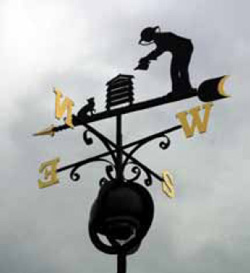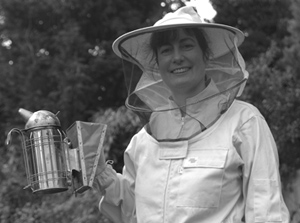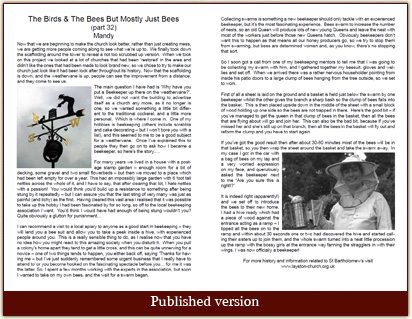Martin & Mandy
Now that we are beginning to make the church look better, rather than just creating mess, we are getting more people coming along to see what we're up to. We finally took down the scaffolding around the tower to reveal a not too scrubbed up version. When we took on this project we looked at a lot of churches that had been 'restored' in the area and didn't like the ones that had been made to look brand new, so we chose to try to make our church just look like it had been look after throughout its' history. Now that the scaffolding is down, and the weathervane is up, people can see the improvement from a distance, and they come to see us.
 The main question I have had is 'Why have you put a Beekeeper up there on the weathervane?'. Well, we did not want the building to advertise itself as a church any more, as it no longer is one, so we wanted something a little bit different to the traditional cockerel, and a little more personal. Which is where I come in. One of my hobbies is beekeeping (others include scrabble and cake decorating – but I won't bore you with a list), and this seemed to me to be a good subject for a weathervane. Once I've explained this to people they then go on to ask how I became a beekeeper, so here's the story…
The main question I have had is 'Why have you put a Beekeeper up there on the weathervane?'. Well, we did not want the building to advertise itself as a church any more, as it no longer is one, so we wanted something a little bit different to the traditional cockerel, and a little more personal. Which is where I come in. One of my hobbies is beekeeping (others include scrabble and cake decorating – but I won't bore you with a list), and this seemed to me to be a good subject for a weathervane. Once I've explained this to people they then go on to ask how I became a beekeeper, so here's the story…
For many years we lived in a house with a postage stamp garden – enough room for a bit of decking, some gravel and two small flowerbeds – but then we moved to a place which had been left empty for over a year. This had an impossibly large garden with 6 foot tall nettles across the whole of it, and I have to say, that after clearing that lot, I hate nettles with a passion! You would think you'd build up a resistance to something after being stung by it repeatedly – but I can assure you that the last sting of very many was just as painful (and itchy) as the first. Having cleared this vast area I realised that it was possible to take up this hobby I had been fascinated by for so long, so off to the local beekeeping association I went. You'd think I would have had enough of being stung wouldn't you? Quite obviously a glutton for punishment…
 I can recommend a visit to a local apiary to anyone as a good start in beekeeping – they will lend you a bee suit and allow you to take a peek inside a hive, with experienced people around you. This is a really sensible thing to do, as I realise now that you have no idea how you might react to this amazing society when you disturb it. When you pull a colony's home apart they tend to get a little cross, and this can be quite unnerving for a novice – one of two things tends to happen, you either back off, saying 'Thanks for having me – but I've just suddenly remembered some urgent business that I really have to attend to' or you become hooked on the fascinating spectacle before you… for me it was the latter. So, I spent a few months working with the experts in the association, but soon I wanted to take on my own bees, and the wait for a swarm began.
Collecting swarms is something a new beekeeper should only tackle with an experienced beekeeper, but it's the most fascinating experience. Bees swarm to increase the number of nests, so an old Queen will produce lots of new young Queens and leave the nest with most of the workers just before those new Queens hatch. Obviously beekeepers don't want this to happen as that means all our honey producers go, so we try to stop them from swarming, but bees are determined women and, as you know, there's no stopping that sort.
I can recommend a visit to a local apiary to anyone as a good start in beekeeping – they will lend you a bee suit and allow you to take a peek inside a hive, with experienced people around you. This is a really sensible thing to do, as I realise now that you have no idea how you might react to this amazing society when you disturb it. When you pull a colony's home apart they tend to get a little cross, and this can be quite unnerving for a novice – one of two things tends to happen, you either back off, saying 'Thanks for having me – but I've just suddenly remembered some urgent business that I really have to attend to' or you become hooked on the fascinating spectacle before you… for me it was the latter. So, I spent a few months working with the experts in the association, but soon I wanted to take on my own bees, and the wait for a swarm began.
Collecting swarms is something a new beekeeper should only tackle with an experienced beekeeper, but it's the most fascinating experience. Bees swarm to increase the number of nests, so an old Queen will produce lots of new young Queens and leave the nest with most of the workers just before those new Queens hatch. Obviously beekeepers don't want this to happen as that means all our honey producers go, so we try to stop them from swarming, but bees are determined women and, as you know, there's no stopping that sort.
So I soon got a call from one of my beekeeping mentors to tell me that I was going to be collecting my swarm with him, and I gathered together my beesuit, gloves and wellies and set off. When we arrived there was a rather nervous householder pointing from inside his patio doors to a large clump of bees hanging from the tree outside, so we set to work.
First of all a sheet is laid on the ground and a basket is held just below the swarm by one beekeeper whilst the other gives the branch a sharp bash so the clump of bees falls into the basket. This is then placed upside down in the middle of the sheet with a small block of wood holding up one side so the bees are not trapped in there. Here's the good bit – if you've managed to get the queen in that clump of bees in the basket, then all the bees that are flying about will go and join her. This can also be the bad bit, because if you've missed her and she's still up on that branch, then all the bees in the basket will fly out and reform the clump and you have to start again.
This can also be the bad bit, because if you've missed her and she's still up on that branch, then all the bees in the basket will fly out and reform the clump and you have to start again.
If you've got the good result then after about 30-60 minutes most of the bees will be in that basket, so you then wrap the sheet around the basket and take the swarm away. In my case I got in the car with a bag of bees on my lap and a very worried expression on my face, and querulously asked the beekeeper next to me "Are you sure this is right!?"
It is indeed right (apparently!) and we set off to introduce the bees to their new home. I had a hive ready which had a piece of wood against the entrance acting as a ramp – I tipped all the bees on to the ramp and within about 30 seconds one or two had discovered the hive and started calling their sisters up to join them, and the whole swarm turned into a neat little procession up the ramp with the bossy girls at the entrance way fanning the stragglers in with their wings. I was now officially a beekeeper!
 |
|
 |

